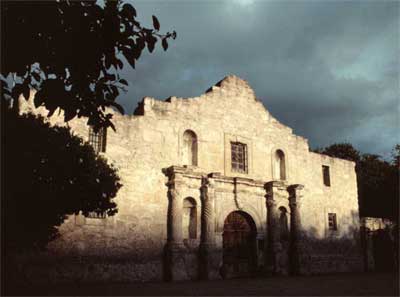



THE
ALAMO

Originally named
Misión San Antonio de Valero, the Alamo served as home to missionaries and
their Indian converts for nearly seventy years. Construction began on the
present site in 1724. In 1793, Spanish officials secularized San Antonio's five
missions and distributed their lands to the remaining Indian residents. These
men and women continued to farm the fields — once the mission's but now their
own — and participated in the growing community of San Antonio.
In the early 1800s,
the Spanish military stationed a cavalry unit at the former mission. The
soldiers referred to the old mission as the Alamo (the Spanish word for
"cottonwood") in honor of their hometown Alamo de Parras, Coahuila.
The post's commander established the first recorded hospital in Texas in the
Long Barrack. The Alamo was home to both Revolutionaries and Royalists during
Mexico's ten-year struggle for independence. The military — Spanish, Rebel, and
then Mexican — continued to occupy the Alamo until the Texas Revolution.
San Antonio and the
Alamo played a critical role in the Texas Revolution. In December 1835, Ben
Milam led Texian and Tejano volunteers against Mexican troops quartered in the
city. After five days of house-to-house fighting, they forced General Marín
Perfecto de Cós and his soldiers to surrender. The victorious volunteers then
occupied the Alamo — already fortified prior to the battle by Cós' men — and
strengthened its defenses.
On February 23, 1836, the arrival of General Antonio López de Santa Anna's army
outside San Antonio nearly caught them by surprise. Undaunted, the Texians and
Tejanos prepared to defend the Alamo together. The defenders held out for 13
days against Santa Anna's army. William B. Travis, the commander of the Alamo
sent forth couriers carrying pleas for help to communities in Texas. On the
eighth day of the siege, a band of 32 volunteers from Gonzales arrived,
bringing the number of defenders to nearly two hundred. Legend holds that with
the possibility of additional help fading, Colonel Travis drew a line on the
ground and asked any man willing to stay and fight to step over — all except
one did. As the defenders saw it, the Alamo was the key to the defense of
Texas, and they were ready to give their lives rather than surrender their position
to General Santa Anna. Among the Alamo's garrison were Jim Bowie, renowned
knife fighter, and David Crockett, famed frontiersman and former congressman
from Tennessee.
"I am determined
to sustain myself as long as possible and die like a soldier who never forgets
what is due to his own honor and that of his country — VICTORY OR DEATH."
Lieutenant Colonel William Barret Travis
February 24, 1836
The final assault came
before daybreak on the morning of March 6, 1836, as columns of Mexican soldiers
emerged from the predawn darkness and headed for the Alamo's walls. Cannon and
small arms fire from inside the Alamo beat back several attacks. Regrouping,
the Mexicans scaled the walls and rushed into the compound. Once inside, they
turned captured cannon on the Long Barrack and church, blasting open the
barricaded doors. The desperate struggle continued until the defenders were
overwhelmed. By sunrise, the battle had ended and Santa Anna entered the Alamo
compound to survey the scene of his victory.
"It could well be
said: With another such victory, we will all go to the devil."
Carlos
Sanchez-Navarro, Mexican Officer
March 6, 1836
![]()
While the facts
surrounding the siege of the Alamo continue to be debated, there is no doubt
about what the battle has come to symbolize. People worldwide continue to
remember the Alamo as a heroic struggle against overwhelming odds — a place
where men made the ultimate sacrifice for freedom. For this reason the Alamo
remains hallowed ground and the Shrine of Texas Liberty.
The Alamo
Defenders
This list contains
names of men who are known to have died in defense of the Alamo. http://www.thealamo.org/defenders.html
Info courtesy
of:
